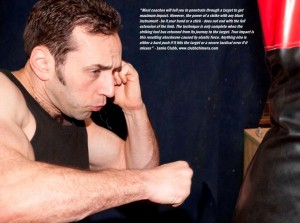Training the Cross (diary entry)
- jamie03066
- Oct 23, 2015
- 2 min read
21.101.15 Continuing my client’s second course on Western Boxing for Martial Arts Cross Training (this his third lesson in this set), we brought in the cross. Here we looked developing force going forwards and backwards from a target in order to create impact. As I have said many times before, one of the biggest natural failings in training is to observe shapes rather than what is driving them. When it comes to punching, people look at fists. Martial arts systems often make a big point about teaching a student how to make a fist and then we have the various different styles – not to mention individuals like the late great Jack Dempsey – arguing over the superiority of a fist’s positioning. Geoff Thompson often tells of how a ridiculous amount of time was taken up during his ABA coaching course, with people arguing over whether a vertical or horizontal fist was best. Bruce Lee seems to have been obsessed about forearm development and the role the strength of these muscles plays in delivering a powerful punch. At least he is looking a little further up the arm, but it still feels like a disproportionate amount of time being put into a certain aspect. My opinion is that punching, like all aspects of fighting, is determined by the situation and the individual. However, I feel that more time should be focused on the whole picture of using any technique. All the hard and intelligent hitters use their entire bodies when they throw a punch and they do so by driving the force up through their legs, using the crucial hinging point of the hips and then transferring it into the shoulder. In order to get the maximum benefit of the strike the arms are as loose as possible and can be likened to whips. When the punch hits the target this whole process needs to be reversed in order create the shockwave impact. Retracting the punch is as important as throwing it. We looked at the cross from its initial set-up using the jab. This began with partner work and the all-important target familiarisation. We looked at the drawing tactic covered in the previous lesson and firing these shots offline in response to a baited opponent throwing their own punches. I focused on coaching asymmetrical explosive actions with the jabs being thrown very lightly and often in repetitions before dropping the heavier yet still relaxed cross. This is good for defeating the instinctive flinch response predictions being made by the opponent. We then did some work on the resistance bands, making sure full extension was achieved and that the right “hinging” muscles were engaged prior to firing the punch. This was also done in reverse, working the retraction of the punch. We then did some conditioning drills to focus on the correct movements needed for strong punching. This included working through a series of medicine balls, where one fighter threw to another, pressing forward, and working a slam ball on the ground, ensuring the fighters pulled the ball off the ground in one fast motion. The session finished with some rear hand palm striking from the fence for a self-defence application.














Comments